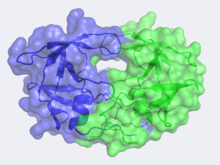User:David Canner/Sandbox HIV
From Proteopedia
(Difference between revisions)
| Line 2: | Line 2: | ||
<StructureSection load='2nmz' size='500' side='right' background='none' scene='User:David_Canner/Sandbox_HIV/Opening/2' caption='Structure of HIV Protease'> | <StructureSection load='2nmz' size='500' side='right' background='none' scene='User:David_Canner/Sandbox_HIV/Opening/2' caption='Structure of HIV Protease'> | ||
=HIV-Protease= | =HIV-Protease= | ||
| - | [[Image:CannergreyHIV2.png|220px|left]][[Human Immunodeficiency Virus (HIV) | + | [[Image:CannergreyHIV2.png|220px|left]][[Human Immunodeficiency Virus]] (HIV) is the cause of Acquired Immunodeficiency Syndrome (AIDS). HIV directs the synthesis of several polyproteins, which each consist of several tandemly linked proteins. The maturation of the virus to its infectious form requires that these polyproteins be cleaved to their component proteins. HIV-1 protease, a homodimeric enzyme, is responsible for doing so and is therefore crucial to the virus's infectious capacity. |
===Structure of HIV-1 Protease=== | ===Structure of HIV-1 Protease=== | ||
Revision as of 06:30, 29 November 2010
| |||||||||||
Additional Resources
For additional information, see: Human Immunodeficiency Virus
References
- ↑ Spinelli S, Liu QZ, Alzari PM, Hirel PH, Poljak RJ. The three-dimensional structure of the aspartyl protease from the HIV-1 isolate BRU. Biochimie. 1991 Nov;73(11):1391-6. PMID:1799632
- ↑ Tie Y, Kovalevsky AY, Boross P, Wang YF, Ghosh AK, Tozser J, Harrison RW, Weber IT. Atomic resolution crystal structures of HIV-1 protease and mutants V82A and I84V with saquinavir. Proteins. 2007 Apr 1;67(1):232-42. PMID:17243183 doi:10.1002/prot.21304


